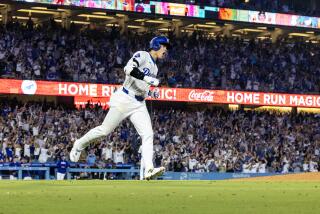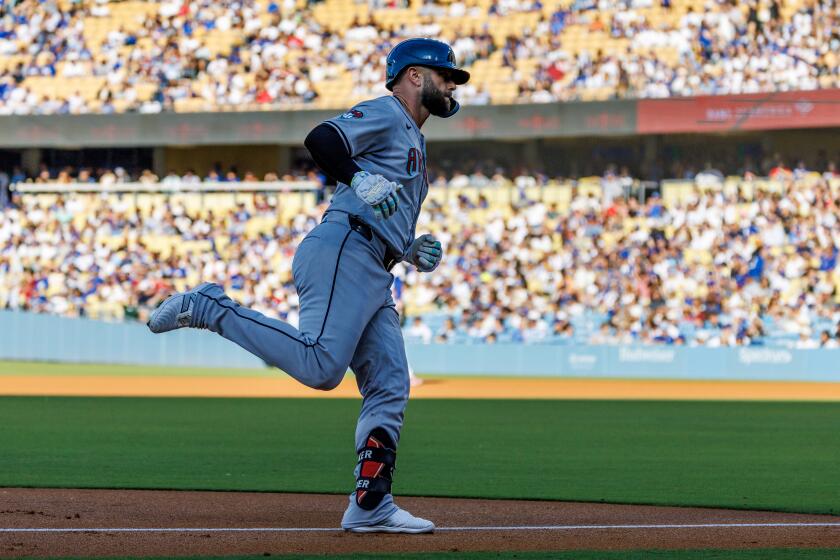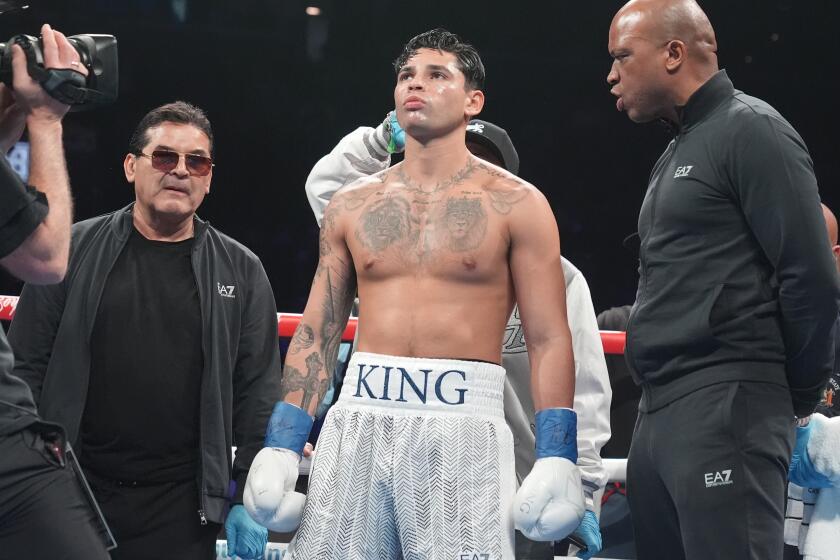He Had Golf’s Sweetest Swing
Sam Snead, whose picture-perfect golf swing carried him to a record 81 PGA Tour victories including three Masters--and earned him a legendary reputation as one of the most gifted athletes to play the game--died Thursday at his home in Hot Springs, Va. He was 89.
Dressed in his trademark straw hat and always quick with a one-liner, Snead was one of the first golfers to draw overflowing galleries with unerringly precise drives that gained him the nickname “Slammin’ Sam.”
For the record:
12:00 a.m. June 6, 2002 For The Record
Los Angeles Times Thursday June 06, 2002 Home Edition Main News Part A Page 2 National Desk 8 inches; 316 words Type of Material: Correction
Snead obituary--Golfer Sam Snead missed a three-foot putt on the final hole of a playoff in the 1947 U.S. Open against Lew Worsham. The distance was incorrect in Snead’s obituary May 24. Also, Snead three-putted from the edge of the 17th green in the 1949 U.S. Open to lose to Cary Middlecoff. He did not miss a three-foot putt on the hole, as reported incorrectly in Snead’s obituary.
His love of competition fueled his longevity: He won his first Professional Golf Assn. title in 1936, and held titles in six decades, winning his last in 1982. Last month, despite his failing health and the need for assistance teeing up the ball, he took part in the Masters’ ceremonial first drives--a tradition he once quipped he’d never give up as long as azaleas grew at Augusta National.
Snead, who would have celebrated his 90th birthday Monday, suffered a series of strokes over the last several weeks and died peacefully at his home with his son and daughter-in-law at his side.
“Sam Snead was probably the greatest athlete that golf has ever had. Very seldom does an all-around athletic man like Sam Snead come along,” said Gary Player, nine-time major champion. “Maybe in time, Tiger [Woods] will prove to be the athlete of this century in golf, but in the last, Sam Snead was the best athlete.”
Many on Thursday mourned Snead’s passing by paying homage to that swing.
“I don’t think there’s ever been a golf swing as aesthetically pleasing as Sam Snead’s,” Phil Mickelson said from the Memorial Tournament.
Added two-time U.S. Open champion Curtis Strange: “It was a gift, something you can’t teach.”
Snead’s natural swing was said to have been developed in his boyhood in the backwoods of western Virginia by practice with a crooked stick and a stone, his accurate eye the product of squirrel hunting.
An all-around athlete, Snead made the football, baseball, basketball and track teams in high school, but he left his mark on golf, starting as a barefoot caddie on a course at Hot Springs when he was 15.
He became a professional golfer in 1935, leaving a job at a restaurant, and would go on to win 135 tournaments worldwide, among them three Masters titles and four other major championships. His 81 PGA tour victories are a feat that some believe may never be broken.
Hootie Johnson, chairman of Georgia’s renowned Augusta National Golf Club, said Snead participated in the Masters, either as a player or as a ceremonial starter, for 63 consecutive years.
“He was one of the greatest golfers ever and he will be deeply missed,” Johnson said.
Snead was a player on seven Ryder Cup teams and the captain of three more.
“The impact on golf is immeasurable,” said Jack Connelly, president of the PGA of America. “A giant of the game has gone, but we will never forget his true love of golf and his fellow man.”
Snead wasn’t a flashy player. His drives, for example, weren’t especially long. Accuracy proved to be the hallmark of Snead’s game. And few players won with such style and grace.
“Nobody had his joyous, rhythmic sweep at the ball,” the late Times columnist Jim Murray wrote in 1995. “He was as loose-jointed as an ocelot, as uninhibited as a cub bear. The golf club was a wand. Watching Snead play golf was like watching Kelly dance, Ruth bat, Tracy act, Koufax pitch or Dempsey punch. A work of art.”
If Snead’s swing was a picture of perfection, his longevity was also a model. The 26-year period between Snead’s victories at Greensboro is one of golf’s more remarkable achievements.
He lived past nearly every contemporary from the field of competition, including Ben Hogan, Lloyd Mangrum and Jimmy Demaret. Only Byron Nelson, 90, remains from that Golden Age of golf. And the two-time Masters champion, who counts five majors to his credit, fondly remembered Snead.
“He was one of a kind,” Nelson said. “He had a swing so sweet, you could pour it out of a syrup bottle.”
But last month at the Masters, where Snead had been an honorary starter since 1983, something was amiss. His sweet swing, no longer flawless, had deserted him.
He was recovering from stroke-like symptoms, his son said, and for the first time he needed someone else to tee up the ball. His ceremonial shot flew wildly into the gallery and struck a fan in the face, breaking the man’s glasses.
Snead will be long remembered, however, for all the shots that flew straight and true.
Though he never won the U.S. Open--the only one of the major championships that eluded him--Snead was a three-time winner of the PGA Championship and bagged his only British Open title at St. Andrews in 1946.
He won the Masters for the first time in 1949, the year club members first awarded a green jacket. He won again at Augusta three years later and in 1954 defeated Hogan by one stroke in an 18-hole playoff.
He finished among the top five nine times at the Masters, among the top 10 15 times.
Although he never had a golf lesson, he had a reputation for being a shrewd competitor who would take on all comers. Once, when he played in a Brazil Open, the sponsor negated prize money. Snead shot a 71. The sponsor thought he was malingering, and reinstated the prize money. Snead shot 63-63-69, much to the sponsor’s fury.
“The money was there for the asking, why not get it,” Snead explained at the time, with a shrug, and the meaning was clear: You want 63s, you pay for 63s.
But he was almost as famous for his near-misses at the U.S. Open, finishing as runner-up four times.
He missed a 30-foot putt on the final hole of a playoff in 1947 against Lew Worsham and two years later a three-foot putt from the edge of the 17th green at Medinah to lose to Cary Middlecoff.
In 1953, a 76 in the final round at Oakmont left him six strokes behind Hogan.
“One has to be very good,” a New York Herald Tribune reporter once noted, “to toss away as many open titles as Snead has done through the years.”
He suffered his most heartbreaking U.S. Open loss in 1939 at Philadelphia Country Club, where the lack of scoreboards on the course played a part. Believing he needed a birdie on the final hole to win, when all he needed was a par, Snead aggressively hit his drive into the rough and never recovered, finishing with a triple bogey.
“That night,” he said later, “I was ready to go out with a gun and pay somebody to shoot me. It weighed on my mind so much that I dropped 10 pounds, lost more hair and began to choke even in practice rounds.”
Of course he was exaggerating.
After joining the PGA Tour in 1937, Snead won at least one tournament in all but one of the next 23 years.
In 1950, he won 11, two more than Tiger Woods would win 50 years later in what has been his greatest season.
And his fellow pros could never get enough of that swing.
“Watching Sam Snead practice hitting golf balls is like watching a fish practice swimming,” John Schlee, a U.S. Open runner-up in 1973, once said.
In his 1946 book, “How to Play Golf,” one of two he wrote on the subject, Snead made it sound so easy. One of his swing tips was to “take it easily and lazily, because the golf ball isn’t going to run away from you while you’re swinging.”
Born in Hot Springs on May 27, 1912, Snead grew up on a farm.
“When I was down on my folks’ farm,” he once said, “we raised almost everything we ate. I did about everything on the farm. Haying was the worst.”
In golf, “He was a genius from the start,” the famed sportswriter Grantland Rice once said.
After Snead won a tournament at Oakland in 1937, only a few weeks after joining the PGA Tour, fellow pro Leo Diegel predicted a bright future for the 24-year-old.
“He’s what I call real,” Diegel told reporters. “Has every shot in the bag. He’s as cool as a cake of ice and compares with the longest hitters I’ve seen. All he lacks at this time is experience. After he gains that he’s going to make it mighty tough for the rest of us. He’s not a flash in the pan.”
Nobody, however, could have predicted Snead’s longevity.
Twenty-seven years after he won the Greater Greensboro Open for the first time in 1938, he won it for the record eighth time in 1965. He was 52, the oldest man to win on the PGA Tour.
It was the last of his 81 victories, 17 after his 40th birthday, but Snead was far from finished.
He helped launch the Senior PGA Tour by winning the inaugural Legends of Golf in 1978 with Gardner Dickinson.
The next year, in the second round of the Quad Cities Open, he became the first player on the PGA Tour to shoot his age, a 67. Two days later, he shot a 66.
Snead is survived by two sons, Samuel J. Jr. and Terry; and two grandchildren. A memorial service is planned in Hot Springs on Sunday.
Reuters and Associated Press contributed to this report.
More to Read
Get our high school sports newsletter
Prep Rally is devoted to the SoCal high school sports experience, bringing you scores, stories and a behind-the-scenes look at what makes prep sports so popular.
You may occasionally receive promotional content from the Los Angeles Times.






